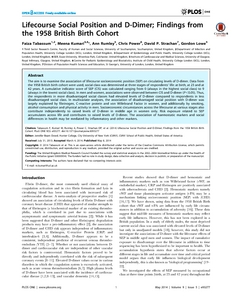Tabassum, F; Kumari, M; Rumley, A; Power, C; Strachan, DP; Lowe, G
(2014)
Lifecourse social position and d-dimer; findings from the 1958 british birth cohort.
PLoS One, 9 (5).
e93277 (1)- e93277 (8).
ISSN 1932-6203
https://doi.org/10.1371/journal.pone.0093277
SGUL Authors: Strachan, David Peter
![[img]](https://openaccess.sgul.ac.uk/107061/1.hassmallThumbnailVersion/pone.0093277.pdf)  Preview |
|
["document_typename_application/pdf; charset=binary" not defined]
Published Version
Download (200kB)
| Preview
|
Abstract
The aim is to examine the association of lifecourse socioeconomic position (SEP) on circulating levels of D-dimer. Data from the 1958 British birth cohort were used, social class was determined at three stages of respondents' life: at birth, at 23 and at 42 years. A cumulative indicator score of SEP (CIS) was calculated ranging from 0 (always in the highest social class) to 9 (always in the lowest social class). In men and women, associations were observed between CIS and D-dimer (P<0.05). Thus, the respondents in more disadvantaged social classes had elevated levels of D-dimer compared to respondents in less disadvantaged social class. In multivariate analyses, the association of disadvantaged social position with D-dimer was largely explained by fibrinogen, C-reactive protein and von Willebrand Factor in women, and additionally by smoking, alcohol consumption and physical activity in men. Socioeconomic circumstances across the lifecourse at various stages also contribute independently to raised levels of D-dimer in middle age in women only. Risk exposure related to SEP accumulates across life and contributes to raised levels of D-dimer. The association of haemostatic markers and social differences in health may be mediated by inflammatory and other markers.
Statistics
Item downloaded times since 17 Jul 2014.
Actions (login required)
 |
Edit Item |



